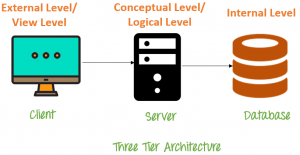architecture is the big picture
many small decisions create architecture
There are several aspects to application architecture which should be interesting to clients.
The first is how the several components that make up an enterprise application connect to each other and how the information flows from one to the other. This aspect is called the application topology and is basically a connections chart.
The second is the physical architecture, where the gory details of hardware and interconnections, based on the topology above, come into play. Smart customers in the cloud age should delegate this responsibility to their cloud provider, agree on service level and up-time requirements, and ignore the physical architecture beyond that point. The subject is intensely hardware technical, and of little interest to clients.
The last and most important aspect is the database architecture, our specialty. All other parts of an enterprise application could fail with relatively minor losses, but if the database fails and the precious data is lost, the application is dead, useless, and the business is in deep trouble.


application topology
Employees, leadership, customers, suppliers – individuals working from different locations using different devices, all talking to the same program – this is the outer, user tier of the enterprise application – the clients which connect. Next, there must be an application server to serve the application to the clients, most often a web server. Last, the web server talks to the database, hidden away in the data center and protected from any direct client connections.

Physical architecture
To realize the enterprise application, real machines are needed, from smart phones to laptops to desktops to workstations to servers. The machines themselves are the most complicated component of a modern enterprise application, a fact customers would do well to ignore. Modern cloud architecture provides the services needed while hiding the unnecessary technical complexity from the customers.

database architecture
By far the most important component of any enterprise system, the database is irreplaceable and must be protected from any possible harm.
The data has to be stored, it has to be available, and it has to be safe. There is lots of it, and it is extremely valuable.
The architecture of the database system is extremely important in guaranteeing these three realities.